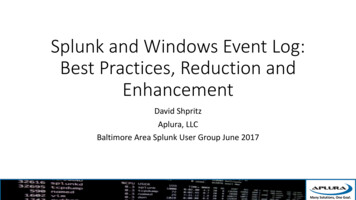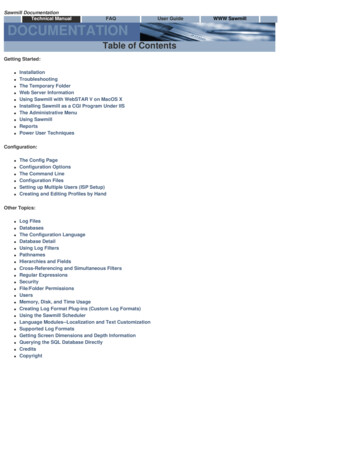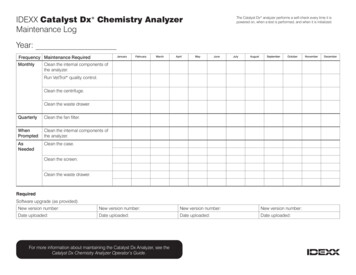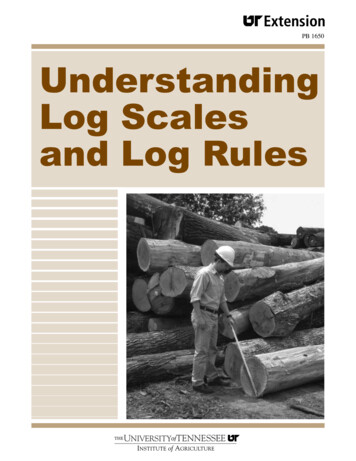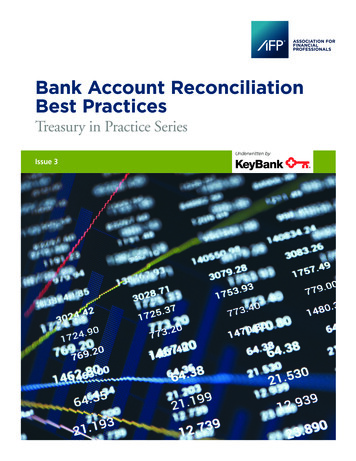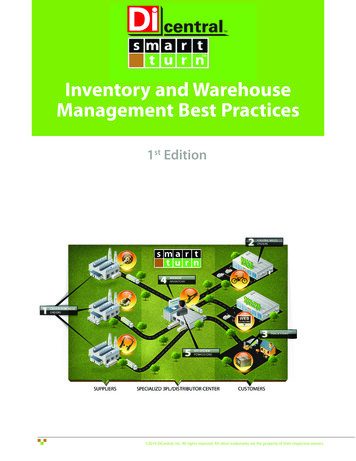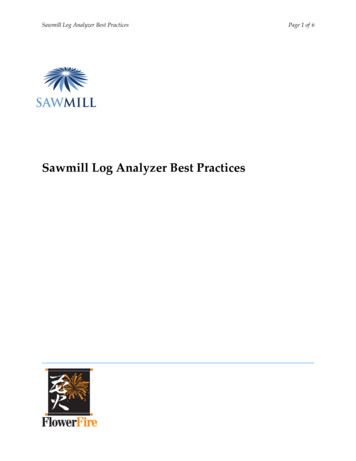
Transcription
Sawmill Log Analyzer Best Practices!!Sawmill Log Analyzer Best Practices!Page 1 of 6
Sawmill Log Analyzer Best Practices!!Page 2 of 6This document describes best practices for the Sawmill universal log analysis software.Log File ManagementLog files are your company’s asset and irreplaceable. We strongly recommend that you retainyour historical log files for as long as possible. If space is a concern consider compressing yourlog files. Log files typically compress down very nicely to anywhere between 90-98% of theiroriginal size. Sawmill is also capable of natively reading compressed files so there’s no need tospend time decompressing files to process them with Sawmill. Compressed log files also reducebandwidth if you are reading log files remotely, or moving files between remote servers. Themost important reason to keep log files is to be able to rebuild your Sawmill database in theevent of a catastrophic failure. If you retain your historical log files recovering a database isalways possible, and it’s a simple operation to rebuild your database. If you choose to followonly one of the best practices and guidelines, make the choice to retain your historical log data.Historical logs are cheap insurance (and typically use very little disk space when compressed)and having them will save you from data loss if you ever need to recover a database from theground up.Backup Your DatabaseWe strongly recommend that if you build larger datasets that you create a backup plan for yourSawmill databases. Having a backup of your database will save you many hours (or even days)of reprocessing logs and rebuilding your database in the event of a database corruption orcatastrophic failure. Though database corruptions or failures are infrequent, they can happen,and if these types of situations do occur you’ll be glad you had a backup of your Sawmilldatabases so that you can be back up and running quickly.The Sawmill internal database is a flat file database and can be backed up by most anycommonly available backup software. It’s important that you schedule backups when theSawmill database is not actively updating. If you use an external database like MySQL, Oracle,or MS SQL check with your Database Administrator about what options exist for backing up orrestoring your Sawmill database.Both the Sawmill internal database, and external databases created by Sawmill can also beexported to plain text files manually, and then compressed, and later decompressed andreloaded manually if no better backup facility is available.Sawmill Scheduled TasksSawmill’s built-in scheduler is very powerful and very flexible and allows you to setup and runmany types of operations in an unattended manner. With this power it’s possible to quickly runinto trouble and overwhelm your server if you set up too many concurrent tasks. We
Sawmill Log Analyzer Best Practices!!Page 3 of 6recommend that you do not schedule multiple database builds or multiple database updatesconcurrently. Sawmill tasks use a large amount of resources (memory, processor, disk space anddisk access) on your server when you are processing and building large datasets. To avoidissues it’s best to schedule large operations consecutively, even on systems with multipleprocessors.Disable Antivirus Active Scanning of the Sawmill Installation DirectoryActive-scanning antivirus software (and automatic disk defragmentation software, or indexingsoftware), which runs continually and monitors all files on the disk, can interfere with Sawmill'soperation. This software may also incorrectly conclude that Sawmill's database files containviruses (they don't), causing it to modify or delete the files, resulting in database corruption.This can cause log processing, database building and report generations to fail. This type ofsoftware also considerably slows Sawmill processing and reporting down, in very extremecases, making it as much as 20 times slower.So, you must disable scanning of the directory where Sawmill is installed, or Sawmill databasesare located in order for Sawmill to operate properly. It is not necessary to disable the activescanning software entirely; just configure active scanning so it excludes the Sawmill installationdirectory and subdirectories and files. Most antivirus products can be configured to excludescanning of certain directories.Best Practices For Setting Up Your ServerOperating System and CPU Platform System requirementsSawmill will run on any platform, but we recommend x64 (64-bit) Linux. You can use anydistribution, but Red Hat Enterprise Linux is a good choice for maximum speed, compatibility,and stability. On other distributions, it may be necessary to build Sawmill from source code.Other x64 operating systems are also reasonable choices, including x64 Windows, x64 Mac OS,x64 FreeBSD, and x64 Solaris. CPU architectures other than x64 will work, but overall we seebetter performance with x64 than with SPARC and other RISC architectures. 32-bit architecturesare not recommended for any large dataset. The address space limitations of 32-bit operatingsystems can cause errors in Sawmill when processing large datasets.We consider a large installation of Sawmill to be a dataset of 10GB or more. For datasets greaterthan 10 GBs we strongly recommend using a 64-bit system, and it is best to have a dedicatedSawmill server.Sawmill can run on a virtual system, but performance can be considerably slower than runningSawmill on physical server. We occasionally see errors with Sawmill running in a virtualenvironment, so physical hardware is always recommended, especially for larger datasets.
Sawmill Log Analyzer Best Practices!!Page 4 of 6Disk and SpaceYou will need between 200% and 400% of the size of your uncompressed log data to store theSawmill database. Databases tend towards the high side (400%) on 64-bit systems, especiallywhen tracking a very large number of numerical fields (more than ten or so). For instance, if youwant to report on 1 terabyte (TB) of log data in a single profile, you would need up to 4 TB ofdisk space for the database. This is the total data in the database, not the daily data added; ifyou have 1 TB of log data per day, and want to track 30 days, then that is a 30TB dataset, andrequires between 60TB and 120TB of disk space.IMPORTANT: If your profile uses a database filter which sorts the main table, e.g., a "sessions"analysis (most web server logs do this by default), there is a stage of database build where theentire main table of the database is copied and sorted. During this period, the database will useup to twice the disk space; after the build, the disk space will drop back down to the final size.So for the example above, if there is a "sessions" analysis or other sorting database filter (anotherexample is a "concurrent streams" analysis), it will temporarily use between 4TB and 8TB ofspace per day, before returning to 2TB-4TB at the end of the build.If you are using a separate SQL database server, you will need space to accommodate the server;the databases use this disk space, and the remainder of Sawmill will fit in a smaller space, so1GB should be sufficient.Sawmill uses the disk intensively during database building and report generation, for bestperformance use a fast disk. Ideally use a RAID 10 array of fast disks. RAID 5 or RAID 6 willhurt performance significantly (about 2x slower than RAID 10 for database builds) and is notrecommended. Write buffering on the RAID controller should be turned on if possible as itprovides an additional 2x performance for database builds.Network mounts will usually work for storage of the Sawmill database but are notrecommended for performance reasons. We sometimes see errors apparently due to locking andsynchronization issues with network mounts.MemoryOn the Sawmill server, we recommend 2GB of RAM per core for large datasets.Processor(s)To estimate the amount of processing power you need, start with the assumption that SawmillEnterprise processes 2000 log lines per second, per processor core for Intel or AMD processors;or 1000 lines per second for SPARC or other processors.Note: This is a conservative assumption; Sawmill can be much faster than this on some datasetsreaching speeds of 10,000-20,000 lines per second per core in some cases. However for sizing
Sawmill Log Analyzer Best Practices!!Page 5 of 6your processor, it is best to use a conservative estimate to ensure that the specified system issufficient.Compute the number of lines in your daily dataset, 200 bytes per line is a good estimate. Thiswill tell you how many seconds Sawmill will require to build the database. Convert that tohours, if it is more than six hours you will need more than one processor. You should haveenough processors that when you divide the number of hours by the number of processors, it isless than 6.For example:50 Gigabytes (GB) of uncompressed log data per daydivide by 200 268 million lines of log datadivide by 2000 134 million secondsdivide by 3600 37 hoursdivide by 6 6 processorsThe use of six hours is based upon the assumption that you don't want to spend more than sixhours per night updating your database to add the latest data. A six hour nightly build time is agood starting point. It provides some flexibility to modify or tune the database and filters thatcan slow down processing and keep within the processing time available each day. The datasetabove could be processed in 9 hours using four processors; if a 9 hour nightly build time isacceptable.Use Internal Database For Best PerformanceThe “internal” database is optimized for performance and database size for Sawmill’s specificusage, and generally outperforms an external SQL server on equivalent hardware. However, anenterprise-scale SQL server, especially a cluster, may provide higher performance than theinternal database, if the SQL server hardware is much faster than the Sawmill server.When using MS SQL, performance of ODBC imports are sometimes very slow, on the order of100 rows per second. For best performance, configure the profile to use BULK INSERT to loaddata into Sawmill, which can run 10,000 rows per second or faster.When using an external SQL database, Sawmill cannot use its efficient representation of“unique” fields like “visitors” or “sessions,” in cross-reference groups. This can make crossreference groups very large and slow when using a high volume of data. For best performance,remove unique fields from cross-reference groups (and associated reports), or remove the crossreference groups entirely. See below for more information on cross-reference groups.
Sawmill Log Analyzer Best Practices!!Page 6 of 6Profile Tuning For High VolumeA default profile created in Sawmill is optimized for maximum report generation speed. Thesesettings can be very problematic for very large datasets (more than 200 million lines of log data),requiring very large amount of time and memory and disk space to build, and should bemodified before any large import begins. It is best to start by turning off most of the databaseindices (all fields are indexed by default), in Config- Database Fields, and most of the crossreferences (in Config- Cross-reference Groups). Turning off cross-reference groups will makethe database build faster, but will make the corresponding report much slower (minutes insteadof seconds). Turning off indices will make the database build faster and the database smaller,but will make filtering on the corresponding field slower. The date/time cross-reference groupshould generally be left enabled, as it is used in nearly every report, and is not very expensive.Field complexity must also be managed for large datasets. Any normalized (non-numerical)field with more than about 10 million unique values can become a performance liability, andshould be simplified or removed if possible. Fields can be simplified using a Log Filter, forinstance setting the field value to a single constant value if it is not needed. Database fields canbe removed completely using the command line “remove database field” action. During alarge database build, it is good to monitor the web interface progress display for the build (clickShow Reports on the profile), to see if there are any performance warnings appearing. Thesewarnings also appear in the TaskLog.Single monolithic databases can also be a performance issue. Whenever possible very largedatasets should be segmented into separate profiles, each with its own database, for instanceone profile per server, or one profile per month, or one profile per region.Pre-Sales Support Strongly Recommended For Large DatasetsIf you are considering Sawmill for a very large dataset (more than 200 million lines of data), it isrecommended that you contact Sawmill technical support in advance, to get expert guidancewith your profile configuration. There is no charge for pre-sales technical consultations, and it isvery likely to improve your initial experience of Sawmill. Contact support@sawmill.net for presales support.Document v2013-04-03-1
Sawmill Log Analyzer Best Practices! !Page 4 of 6. your processor, it is best to use a conservative estimate to ensure that the specified system is sufficient. Compute the number of lines in your daily dataset, 200 bytes per line is a good estimate. This

